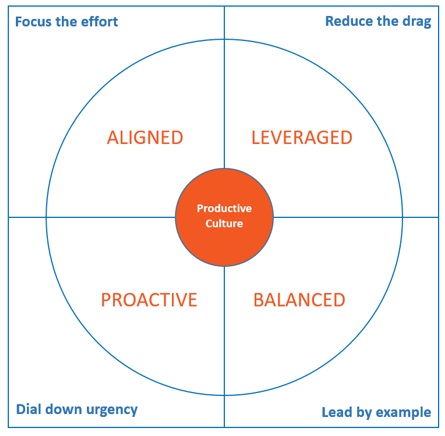Leading productivity
Most organisations are still driven by urgency and reactivity. Dermot Crowley says an aligned, leveraged, proactive and balanced work culture starts at the top.
I was recently coaching a senior manager of an international technology company, specifically around his productivity. I was shocked at just how reactive his week was. He seemed to lurch from one fire that needed putting out to another. His days were full of urgent meetings, many only scheduled that day or at best the day before. His plans were non-existent, as they changed so often he felt like there was no point planning. When he did get to sit at his desk he was invariably interrupted. So he did not even try to get anything done except to crunch through a few urgent emails before the next crisis arrived.
For him this was normal, and he assumed this was what it was like in every team in every organisation. Thankfully it is not. But I am sure many of us see this happening at some level in our own organisations. In my experience, most organisations are driven by urgency and reactivity. When is everything needed around here? Yesterday is the common answer! But industries are not reactive by nature. Neither are organisations. It is people and their workstyles that cause urgency most of the time. And it often starts at the top.
Productivity needs to be led from the top, by the leadership team, senior partners and key influencers like HR and Learning & Development. It is not enough to just throw training at individuals in this space. Expectations need to be set. Behaviours need to be modelled. And senior partners need to ensure they are amplifying the productivity of their people, not dragging it down. The impact that a productive culture can have on an organisation cannot be underestimated. And this does not just come from introducing the latest performance planning frameworks, or an activity-based workplace. It comes from how we personally organise and manage our work, and how every individual interacts with every other.
The four elements of a productive culture
There are many forces at play when creating a culture of productivity, but I believe four elements are critical. A productive culture is Aligned, Leveraged, Proactive and Balanced.
An aligned culture
The goals and objectives of an organisation are set by the leadership team, and should drive the efforts of every person in the organisation. What each person works on will either assist with achieving these outcomes, or not. If not, there is an opportunity cost that can have a major impact on the overall productivity of an organisation. It is critical that leadership aligns the efforts of each team and individual towards the objectives.
Unfortunately, I often see people working long hours being extremely busy, but not working that effectively. They spend a lot of time churning through activities, but complain they are not getting to the really important work. Or sometimes think they are doing the important work, when actually they are doing the wrong work. Because partners and managers are so busy in meetings and dealing with urgent issues, they may not take the time to align, and make sure the team is all working on the right work. This alignment creates an organisational focus that is powerful, like a super-strength laser beam. But without alignment the laser light gets dissipated and is ineffective.

A leveraged culture
I reckon there is two types of work in our role. ‘Above the line’ work, which are things that are an excellent use of our time and our skillset, and ‘below the line’ work, which are things that are not a great use of our time and skillset. One of the challenges of working in a lean organisation (and let’s face it, most companies need to get as lean as possible to compete today) is the fact that there are fewer resources to go around.
This can mean that we too often get dragged down below the line to work on things that may be urgent, but not a great use of our time. In this scenario, leadership need to work on helping every worker to leverage their time and stay above the line as much as possible in their role. This requires them to look at creative ways to reduce the drag for workers. Too many meetings, bureaucracy, unnecessary emails, rework and poor work processes all create drag that can pull you below that line.
A proactive culture
Why is everything so urgent these days? Are we creating a sense of urgency, or senseless urgency? I believe that email has increased the urgency in many organisations. What started out as an asynchronous tool has become a synchronous one. We send emails and expect an instant response. Many people use their Inbox as their default screen when at their desk, and we just churn through all the ‘urgent’ messages, all day long.
The issue of urgency is often blamed on the industry or the organisation. People say to me that this is just how it is in the retail industry, or the finance industry, or (insert industry). But urgency is not an industry issue or an organisation issue. It is an individual issue. Urgency and reactivity are caused by people and their workstyles 99% of the time.
There are four types of urgency. Real urgency – things that are truly urgent, and false urgency. Many people have worked out that the best way to get stuff done is to become the squeaky wheel that gets oiled. We need to be able to differentiate and negotiate if we feel that something is not really urgent. At the same time there is reasonable urgency – things that are urgent and could not have been planned for, and unreasonable urgency. The latter are things that either other people left until the last minute, or you left until the last minute. This can be avoided and should not be tolerated.
Unfortunately, I often see the false and unreasonable urgency cascading from the leadership team down. How can leaders expect their teams to be productive if they are a part of the problem? So leadership need to dial down the urgency, and facilitate working in a proactive way.
A balanced culture
Lastly, we need more balance. There is a lot of talk about work-life balance, but I reckon we need to go beyond some of the simplistic strategies for modern working if we want to create a real culture that embraces balance. Long working hours, constant pressure to achieve billable targets and killer deadlines all lead eventually to burn-out. In this regard leadership needs to lead by example. Each generation of leaders copies the last in many ways, and for many generations the DNA being passed down the line has been out of balance.
We have got to get back to working a reasonable number of hours. Being extremely focused and productive during core working hours should mean that you can get it all done and have a life. We need to get back to a slightly slower pace that allows us to do what we get paid to do – think! And we need to get back to a workplace that is driven by what is important, not by what is merely urgent.
Dermot Crowley is a productivity thought leader, author, speaker and trainer. Dermot works with leaders, executives and professionals in many of Australia’s leading organisations, helping to boost the productivity of their people and teams. He is the author of Smart Work, published by Wiley. For more information, visit www.dermotcrowley.com.au or email dermot.crowley@adapttraining.com.au










